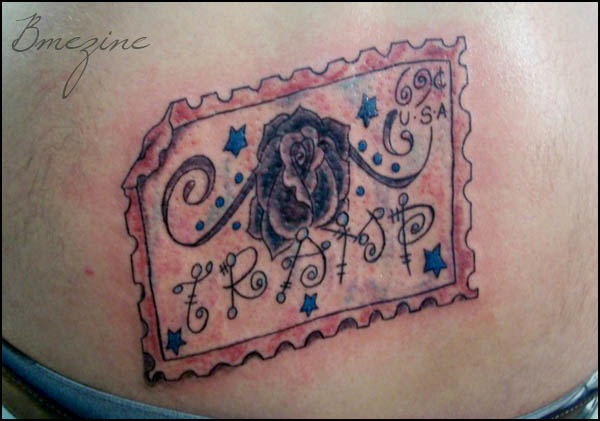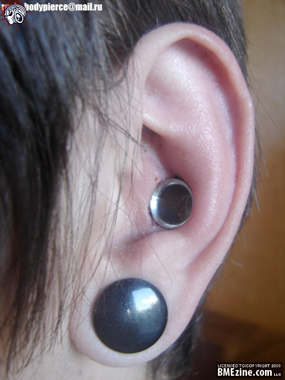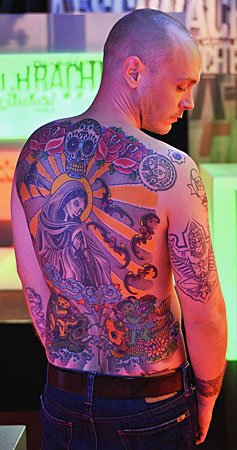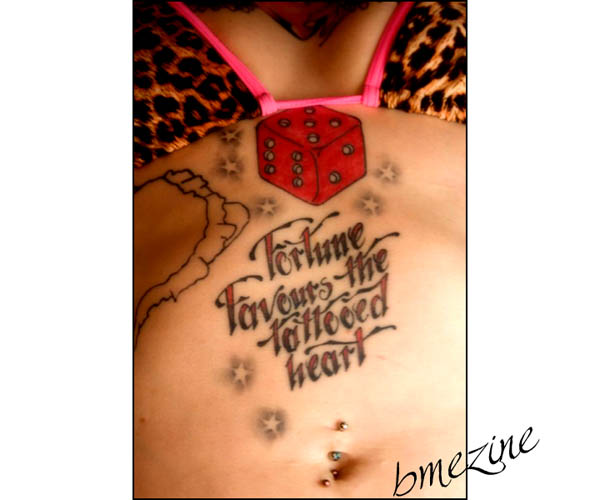
Stamped by Dani Demo, Dyeing Rites Tattoo, Elizabeth City, NC.

Stamped by Dani Demo, Dyeing Rites Tattoo, Elizabeth City, NC.
Does this photo of Rafa giving his girlfriend Mila some “lip service” remind you of anything?

See more in “Scalpelled and other large gauge lip procedures“ (Lip Piercing)
Though I think it’s usually dumb and misguided, I have a hard time taking issue with a company that institutes a dress code that prohibits visible, tasteful modifications — by all means, that sort of thing is up to the discretion of the owner. When it comes to a school board banning them, however? It often comes off as an arbitrary and thoughtless use of power. So it goes in Portales, New Mexico: 13-year-old Kierra Seales has been informed that the clear bead she wants to wear in her lip piercing is unacceptable, and that the piercing will have to come out while at school. Her mother, Nkoshe, is calling it a First Amendment issue:
 |
| Photo credit: PNT / Mickey Winfield |
“If we could accomplish changing the wording of the dress code, both sides would benefit,” Nkoshe Seales told the board. “The students would feel like they have the freedom to express themselves, and the administration and staff would no longer have to make an issue of the fashion trend.”
The current Portales schools’ dress code policy for piercing states that no student shall wear nose rings or nose studs or any type of visible body piercing accessory with the exception of earrings in the ear. […]
“The First Amendment is freedom of expression. Whether youth have First Amendment rights is still a legal question, but what is not in question is that they will (have them) some day,” Nkoshe argued. “Constraining them now from expressing themselves is no preparation for exercising those rights.”
Nkoshe has opened up a dialogue with the school board on the issue, and the board’s superintendent, Randy Fowler, seems open to reviewing the current rules and determining if a change in order. Nkoshe’s argument goes beyond a simple constitutional defense, though, and insists there are tangible benefits to body piercing:
“Piercing is a healthy and positive thing in some people’s lives,” Nkoshe said. “It encourages personal growth and self-discovery. Body piercing is the safest and most positive (expression) a youth could embrace given the alternatives of drugs, sex and gang violence.”
Well, I’m not sure those are the only alternatives, but … what do I know? Let’s see what the readers of the Portales News-Tribune have to say!
I wonder what this mother would think if Portales Schools went to using school uniforms? With the large number of students now, it would be helpful to the teachers if they knew who exactly should be on campus for safety reasons. Does she think teachers should also be able to express themselves by wearing what they would like and showing what they would like?
Hmm … well, the teacher issue seems like a bit of a straw man, but I’ll grant that if it’s a particularly problematic area, uniforms shouldn’t be discounted immediately. Even still though, aren’t piercings compatible with the institution of uniforms? One would think …
“I hope the School Board will remain firm in the set policy. Wearing a pistol on the hip, running naked in the streets are all part of self expression however thankfully there are laws and rules. Our schools are to teach. Teaching rules is part of education. This is why children are willful today.”
“Please change the rules for me because I am more special than all of the other kids who have gone through these schools and followed the rules. BULL!!!! I think it would be a very different circumstance if someone were to go into their place of business here in town and urinate in the floor. I think Ms. Seales would be very upset with you, and I don’t think she would be any happier if you told her that it was ok and should be allowed because you were just expressing yourself on the carpet.”
Oh, God damn it.
Mother protests school district policy on piercings [Portales News-Tribune]
If you’re black or white (or a mixture of both)..

By Belly, Perpignan, France.
See more in “Wildlife and Nature Tattoos“ (Tattoos)

(Editor’s note: This article was first published in The Point, the publication of the Association of Professional Piercers. Since part of BME’s mandate is to create as comprehensive and well rounded an archive of body modification as possible, we feel these are important additions.
Paul King, the article’s author, has given BME permission to publish a series of articles he wrote for The Point that explore the anthropological history behind many modern piercings. This is another in that series.)
In the piercing world we have come to call the piercing of the ear’s concha a “conch” piercing, pronouncing the ch softly, as in “church.” However, per Webster’s New World Dictionary, 2nd edition, the correct pronunciation of the ch should be hard, sounding like the letter “K.” I bring this up merely as a matter of curiosity or trivial fact; I am certainly not suggesting the piercing community should stray from tradition. Sometime in the early 1990s, the original Nomad body piercing shop in San Francisco, owned by Blake Perlingieri and Kristian White, started referring to this piercing as the “Sadhu,” a rather catchy name that has stuck to an extent, and which refers collectively to Indian Hindu holy men. “Incorrectly they are sometimes referred to as ‘Fakirs’ who were originally Moslem street magicians who adopted a few yogic techniques for their repertoires and used them solely for entertainment.”1 It is a particular subsect of these Sadhus, the Gorak Naths or Gorakhnathis, that have their conchae pierced.
 There is little historical documentation of the conch piercing, and its practice seems sporadic within different cultures. Other than the Gorak Naths, I have only found the Mangebetu to have strong cultural ties to the perforation and adorning of the Concha.
There is little historical documentation of the conch piercing, and its practice seems sporadic within different cultures. Other than the Gorak Naths, I have only found the Mangebetu to have strong cultural ties to the perforation and adorning of the Concha.
The Mangebetu, sometimes spelled Mangbetu, are an African tribe found in the Republic of Zaire (previously known as Congo). The Mangebetu were formerly regarded for their sophisticated court and developed arts; it is the women of this tribe that can still be seen wearing the beautiful long pieces of ivory in their conchae. The conch perforations often “hold monkey bones which are used to part their hair,”2 though sometimes, the bones were simply for decoration. In the past when elongation of the skull was more widely practiced, and hair styles were worn high to accentuate the skull’s shape, the conch jewelry was used to support the hair. The woman’s hair was sometimes extended using hair from the dead of an enemy tribe.
It’s impossible, of course, to say when the conch piercing was practiced for the first time. The history of the Sadhus has been long debated. Some archeologists believe that asceticism was implicit in the teachings of the Rg-Veda, written in the Vedic language, what we know as “The Vedas”, holy texts which came to India with the “invasion” of the Nordic Aryan Tribes around 1500 B.C.E. These Aryan tribes became the upper castes, the Brahmans, in the Hindu society. The other camp believes that yogic ascetic and other shamanistic practices can be traced much further back to the Indus Valley Culture, already fully developed in 2500 B.C.E. As is usually the case in history, it’s probably a little of both.
 “Almost nothing is known of the historical Gorakhnath. His personality was quickly distorted by myth and magical folklore … It seems he was an ascetic yogi who lived sometime around the ninth to 12th C.E. He established a new synthesis between Pasuhupata Shaivism, Tantra and the so-called Teachings of Siddhas. He was closely linked with Vajrayana (Tantric) Buddhism, and is also credited with the authorship of a lost treatise, called simply Hatha Yoga, and with the foundation of the movement of that same name. His teachings also involve the so-called “left-hand path” of Tantra, which involves sexual tantra with a partner, as opposed to simple visualization (the “right-hand” path).”3
“Almost nothing is known of the historical Gorakhnath. His personality was quickly distorted by myth and magical folklore … It seems he was an ascetic yogi who lived sometime around the ninth to 12th C.E. He established a new synthesis between Pasuhupata Shaivism, Tantra and the so-called Teachings of Siddhas. He was closely linked with Vajrayana (Tantric) Buddhism, and is also credited with the authorship of a lost treatise, called simply Hatha Yoga, and with the foundation of the movement of that same name. His teachings also involve the so-called “left-hand path” of Tantra, which involves sexual tantra with a partner, as opposed to simple visualization (the “right-hand” path).”3
“The main symbol that characterizes the Gorakhnathis, are huge earrings worn in split ears. Gorakhathis are also called Kanphatas or Kanphata Yogis (‘Kan’ meaning ear and ‘phat’ meaning split), because at the initiation ceremony the ears are split to insert enormous earrings. These earrings are commonly called yogi’s earrings and are made of agate, glass and various materials. Traditionally rhinoceros horn was a favorite because of its durability and because it is a sacred animal. Such rings covered with gold have been found. The wearing of the earrings is of great importance. If one is broken, another must be substituted before the yogi can eat, engage in conversation or carry out religious duties. Modern adherents claim this piercing the central hollow of the ears is a technique by which the acquisition of magical powers is promoted.”4
The piercing procedure is performed “with the double edge ‘Bhairavi knife’ (Bhairavi is a manifestation of Shiva). Before the operation, the Nath Babas are called Aughars — meaning ‘unfinished’ — and many will never reach the second stage.”5 It is not known at what point in the development of this subgroup of Sadhus, that they began piercing their conchae, if they originated the practice or if the practice existed in a previous sect. They have certainly been the only Hindu practitioners of this ritual for some time.

My usual disclaimer: I am not an anthropologist. From time to time, there will be errors. Please be understanding and forth coming if you have any information you would like to share.
Please consider buying a membership to BME so we can continue bringing you articles like this one.
![]()
 |
| Photo credit: Paolo Foschini |
Over the course of 35 hours, Belgian artist Wim Delvoye — famous for, among other things, tattooing live pigs and just generally pissing people off — tattooed a more-than-decent image of the Virgin Mary on the back of Tim Steiner of Zurich. The tattoo was part of a larger plan, however:
The tattoo on Tim Steiner’s back was bought last week by a German art collector for €150,000 (SFr240,000) in a deal coordinated by the Zurich gallery De Pury & Luxembourg.
The gallery, Belgian artist Wim Delvoye and 32-year-old Steiner all took a cut of the money.
In return Steiner is required to exhibit the work three times a year in public and private shows, the first of which will be the Asia Pacific Contemporary Art Fair in Shanghai next week.
The sale agreement extends further, stating that after Steiner’s death the tattoo and its skin canvas will revert to the new owner, contemporary art collector Rik Reinking.
The content and execution of the tattoo itself is largely irrelevant — indeed, the fact that it was conceived as a commodity to be profited off of was an “integral part of the work itself.” It’s an interesting concept, and while there’s a certain forward momentum in tattoo work being seen in the context of fine art, this seems to be more about making a statement about what could potentially be valued as art — the performance aspect rather than a showcase of the art itself. It’s not a bad tattoo by any means, but given the fact that it was dreamt up with profit in mind with a secondary focus on what was produced, is it all that much more than a high-brow version of Brent Moffatt’s Golden Palace advertisement?

OK, maybe Internet vitriol doesn’t quite count as breaking news, but when it’s as enjoyable as this, it deserves its own headline. Local hothead and 9/11 Truther Anthony Bosco really, really doesn’t like your stupid tattoos. Hates them! And by golly, he wants you to know it.
Tattoos are nothing but a commitment towards future embarrassment and ridicule. You may think that who you are now will never change. And if you are a wilfully ignorant or narrow-minded person who will always refuse to change their perspective on the world, irrespective of how much things around you change, you may be right. At least in terms of your mental retardation, anyway. But, what you are most certainly incapable of retarding, is the inevitable physical changes to your body as you begin to age.
And yes, I have heard all the argument before…”It’s okay if I get saggy and my tat ends up looking stupid, because I’ll be old and covered up anyway, so no-one will see it”. Really? Isn’t people seeing it the whole point of getting ink injected permanently beneath five layers of dermis? Because this excuse sounds an awful lot like an admission of the temporary relevance of whatever statement, symbol, character, etc. you have had tattooed to your body.
He says what we’re all thinking! But wait, there’s less:
And before anyone pulls the “But I got my children’s names tattooed across my heart because I’ll always love them” card, just hold up a minute. You can’t be serious, can you? If you need a massive tattoo across your chest, back or forearm to stand as a reminder of how much you will always love your children – then you really don’t love your children! You just want other people to think that you do. People who really and truly love their children do not need to advertise it on their flesh!
Now, this is something with which I agree. Displays of affection for loved ones? Over it! While we’re at it, all you poseurs who hang pictures of deceased family members in your homes? Cut the crap. We know you’re just trying to trick visitors into thinking you loved Grandma. God, you are so selfish.
Elsewhere on the Internets, Tyler F. Williams unleashes the hate for Danielle Lloyd — allegedly some sort of British pseudo-celebrity — who just recently got this transliterated Hebrew tattoo:
Not only is the tattoo gibberish; it isn’t written in Hebrew (i.e., the language) at all! When I first looked at the pictures of the tattoo, I couldn’t figure it out. It wasn’t Biblical Hebrew. I didn’t think it was modern Hebrew. I was looking up words in my modern Hebrew dictionary and starting to think that I shouldn’t be teaching Hebrew this semester! Then I figured it out. The tattoo isn’t written in the Hebrew language, but is English written with Hebrew letters! If you transliterate the Hebrew characters into their English counterparts, voila!, you get the supposed translation: “Only God can judge me, only God can judge me.” What makes this even more silly utterly ridiculous is that the transliteration isn’t even consistent. In the first occurrence, “can” is spelled qof-nun (קן) while the second time it is spelled kaf-nun (כן). Not only doesn’t Danielle know Hebrew, she apparently doesn’t even know how to spell “can” in English! (I won’t even comment on the rest of the supposed transliteration)
If there was a prize or award for the dumbest tattoo, this should certainly win. I just can’t believe it… this is beyond stupid.
In all fairness, Williams’s objections are based in the fact that the tattoo is an affront to his passions and his studies. Bosco is just a dick.
A tattoo is a permanent reminder that you are an idiot [Anthony Bosco’s Weblog]
Danielle Lloyd: The Dumbest Hebrew Tattoo Yet! [Codex: Biblical Studies Blogspot]
I think Steve might have meant boogers (I prefer buggers, personally) but either way here he is wearing a new 5/8″ curved barbell in his Hobo piercing..
“For those who are interested but don’t know what they are, they go in like a Monroe but instead of going through into my mouth they curve upwards inside my lip and exit in my nose.
Not too sure what to call them! A couple of friends have dubbed them the Hobos (for obvious reasons). I’m glad they seem to be working out well, but I do know they are still very new and who knows what is to come with them. For now I’m very happy with them!“
By Sque3z, Anomaly Studios, Pasadena, CA.
See more in “Misc. Deep Piercing“ (Surface & Unusual Piercing)
